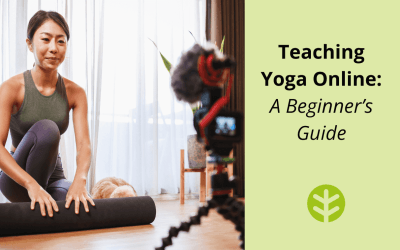Are you a yoga teacher who is trying to come up with new ways to find and engage with new students? Setting up an online yoga challenge could be a great way to extend your reach and build your own community!
You may have participated in an online challenge before. Whether it’s a yoga, meditation, fitness, or clean eating challenge, people love a good challenge to help motivate, inspire and kickstart new habits! To get started with developing and running your own online yoga challenge, check out our suggestions on how to organize an online yoga challenge:
What is the goal of your challenge?
In other words, why go through the work of setting up a yoga challenge in the first place? This is important to clarify for yourself before proceeding with planning the details and logistics.
If you’re not really sure if running a challenge is good for you or your yoga business, consider some of these reasons and benefits of setting up a yoga challenge:
- Providing a free yoga challenge can be a welcoming entry-point for new students who aren’t ready to book a class with you yet but want to try yoga
- A yoga challenge can increase social media followers and build your email list
- Offering a yoga challenge provides you with a platform to teach yoga and showcase your expertise
- Generate content that you can repurpose on a blog, website, or social media
- Strengthen your yoga community – especially if you offer space for challenge participants in a Facebook Group or another discussion forum (more on that later).
What will be the theme or topic of your challenge?
Ready to run your first yoga challenge? Awesome! Next, you’ll need to brainstorm what will be the theme or topic of your challenge. This will anchor the challenge and help you make sure that the content you create makes sense and is easy for the participant to follow.
A good starting point is to think about a problem, issue, or question that a student might have that you could help them with. This yoga challenge is an opportunity for you to showcase your expertise and give participants a taste of what you can offer them if they end up signing up for one of your yoga classes or workshops!
Another helpful tactic is to work backwards. In other words, what do you hope participants will achieve or take away from being part of the challenge? Picturing their success can inspire what your challenge will be about and what kind of content to create for it.
Still feeling stumped? Here are some ideas and prompts to help you brainstorm themes for a yoga challenge:
- Center your ideal student or audience. For example, if you specialize in kids and family yoga, what might be some kid-friendly yoga poses that parents and children could practice together?
- What time of year is it? Are there any holidays coming up? Creating a yoga challenge around a holiday or season can be a fun way to help participants shake up their yoga practice and have some fun. For example, when summer rolls around, you could create a challenge that is themed around things we associate with summer such as the sun, heat, or the dog days of summer.
- Don’t forget the beginners! If you teach beginner’s yoga, keep it simple and offer a challenge that takes participants through some of the fundamentals and foundations of yoga.
- Help busy people find ways to incorporate yoga into their days by creating a challenge that provides creative ways to do yoga while at work, waiting for the coffee to brew, or lying in bed before they go to sleep.
Whatever you come up with, just ensure it feels authentic to you as a yoga teacher and that it is an accessible entry-point for students who are curious about ways to either begin or strengthen their yoga practice. Even though the challenge is primarily to help grow your yoga business, it’s super important to make sure your students also feel a benefit! It should be a win-win for everyone involved.
How long should a yoga challenge run for?
People like quick wins so setting up your challenge for success is important. There’s no right or wrong length of time for a yoga challenge but a good rule of thumb is to keep it shorter rather than longer. Anywhere from 5-7 days can be a good range for a challenge.
It might be tempting to think that a 30-day challenge is better because it’s longer but not necessarily. People are busy and over the course of a month, you risk a higher attrition rate.
Remember, you want to set up your participants for success and keep them engaged. Like you, they are busy, too. Also, the purpose of your challenge is to reach new students and show how you can help them with their goals. Think of this yoga challenge as a sample of what you can offer.
Plus, keeping the yoga challenge shorter means you have to create less content and can stay focused on running all of the other aspects of your yoga business. Another thing to consider: If your challenge is successful, then you could repurpose all of your work and run the same challenge throughout the year, and continually get new leads.
How should you deliver your yoga challenge?
Even though social media challenges are popular, we recommend delivering your yoga challenge by email.
You can always share some of your challenge content on social media in order to get people to your website to sign up for your email list and challenge.
Creating online communities on a platform like Facebook Groups can be another incentive for people to sign up for your online challenge. Though moderating the group is an extra step, this addition can really help build a like-minded community that can support each other throughout the challenge (and after the fact!). Another bonus – if members post pictures or videos in the group, this can become potential content that you can use (with the poster’s permission).
What to do after the challenge is done
If you used email to deliver your challenge, keep the communication going! The challenge was the first step for new students. Continue to nurture your relationship with challenge participants. For example, you could offer a special membership or develop an email nurture campaign.
Take time to reflect on what went well with the challenge and what didn’t. Adjust accordingly and if you are happy with how the challenge went, you can think about how to scale it. If your challenge was a theme that you can use year-round (for example, 7 Days of Yoga At Work), roll it into your marketing plan and offer it again. The challenge might become something that you can run a few times a year; the beauty of this is that you did all the hard work at the top and don’t need to reinvent the wheel each time!
Have you set up a yoga challenge before? What went well? What did you wish you did differently? Drop us a note in the comments!




